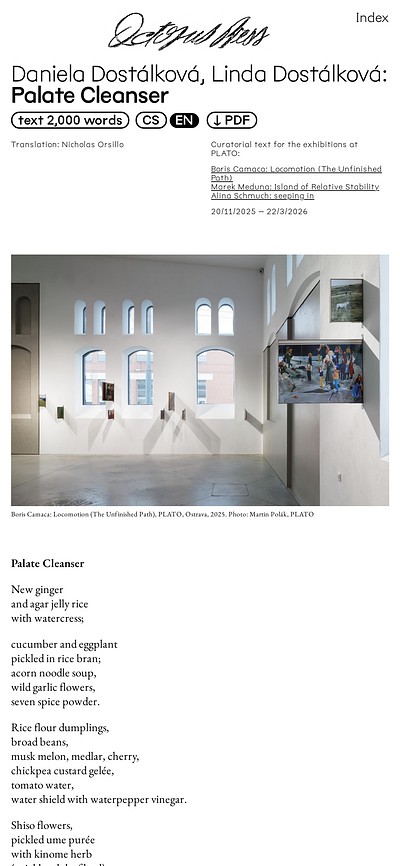Monika Pascoe Mikyšková: Memories that aren’t mine
Curatorial text for the exhibition at PLATO.
Monika Pascoe Mikyšková:
Memories that aren’t mine
20/11/2025 – 22/3/2026
Monika Pascoe Mikyšková’s earliest memories of her grandmother motivated her to create this exhibition:
“A meadow on a hill, we are bending over together and gathering yellow flowers. I am at my grandmother’s side, I am four or five years old. I ask what the herbs are used for, and my grandmother answers, for cleansing. This is the oldest memory I have of us together. A year after her son died, she is gathering St. John’s wort at our cottage.”
Perforate St. John’s wort (Hypericum perforatum) is known for its use as a nerve calmer, a sleep aid, and an antidepressant. The word hypericum comes from the Greek hyper (above) and eikon (icon), after a custom of hanging the herb above icons as a protection against evil. In ancient Greece and Rome, it was often burned to ward off evil spirits and diseases. When cows ate St. John’s wort in their pastures, its red fluid turned their milk pink, which people in the Middle Ages incorrectly attributed to an evil spirit possessing the cows.
Monika Pascoe Mikyšková is interested in plants and their medicinal effects. Plant life has pervaded her work for many years. This does not mean that she merely depicts flowers, leaves, and seeds, although herbaria and various forms of observation and botanical research inspire Monika and are close relatives to her work. Rather, she relates vegetal existence to human emotions. She does not make direct use of anthropomorphization as we know it in our culture. Rather, she connects the human – and feminine – world with the vegetable world, as if plant tissue had direct connections and consistency with human organs and skins. As if her drawings and paintings mixed plant fluids with human bloods and bodily fluids. As if the stories and emotions of people and women could only possibly be fully told in conspiracy with the stories and emotions of plants.
Monika strives to record human–vegetable history, proximity, and corporeality. She fuses plant symbolism into an intermingling bionarration. She does not make portraits of plants, no matter how much the forms of her individual works may resemble them. She tenaciously strives to penetrate into the internal reality of organisms, the human psyche, the microscopic landscapes of plant cells and tissues intended as a language for possible more-than-human communication and transfer of emotions.
The color of the exhibition is red, understood both symbolically and not. It is the color of the fluid of St. John’s wort, which has sedative effects. It is a color laden with meanings, history, and power, a color both sophisticated and instinctive, the color of both royal symbols and women’s emancipation. The drawings and paintings themselves lack the stylization present in the artist’s earlier work – which finds more of an application in the objects of metal herb flowers which, hung from above, come near our heads, where they affect the neurotransmitters in our brains.
Yet another memory of the artist’s grandmother’s garden materialized in a photograph captures the artist, her brother, and her cousin in childhood. It comes from the same period – in the high grass, which her grandmother only cut after the daisies finished flowering, three small bodies stand together. Memories feed this exhibition. Rememberance with plants is a form of narration missing from great human history. The memories of St. John’s wort thus become not just the artist’s memories, but also those of her grandmother – and, at the same time, the memories of all those who have ever gathered it.
Edith Jeřábková
Monika Pascoe Mikyšková lives and works in Bratislava, where she also earned master’s and doctoral degrees from the Academy of Fine Arts and Design. In 2004 she had a residency at Roxy Walsh’s studio at the University of Newcastle upon Tyne in Great Britain. She was a finalist for the 2022 Oskár Čepan Award. In 2019 and 2023, she received a grant from the NOVUM Foundation, and in 2015, she won the Collection Invitation Prize in the Essl Art Award CEE competition. Monika Pascoe Mikyšková has long been interested in the relationship between humans and plants, plant ritual, ethnobotany, ecology, and shared more-than-human emotionality.
- Language
- Type
- Palate Cleanser2025
- cs
- en
text- 2,000 words
- Monika Pascoe Mikyšková: Memories that aren’t mine2025
- cs
- en
text- 500 words
- Kino Kosmos under the Cosmic Sun2025
- cs
- en
text- 9,800 words
- Kino Kosmos2025
- cs
- en
text- 3,700 words
- Dorota Jurczak: Pyk, Sciak etc.2025
- cs
- en
text- 1,500 words
- Sprouts2025
- cs
- en
text- 800 words
- Curatorial text for the exhibition by Petr Bosák, Robert Jansa and Adam Macháček2025
- cs
- en
text- 900 words
- Curatorial text for Martin Zetová's exhibition2025
- cs
- en
text- 1,100 words
- Cello & Piano2025
- cs
- en
audio - Primeval Forest, Garden and Wall2024
- cs
- en
- pl
text- 1,100 words
- Interview with Barbora Lungová2024
- cs
audio - Barbora Lungová and the gift of painting2024
- cs
- en
text- 1,400 words
- Julie in the Worlds of Fantasy. Marginalia.2024
- cs
- en
text- 1,600 words
- Pigeon newspaper2024text
- Workbook for children The Shell No. 32024
- cs
- en
text- 200 words
- Zvířecí kustodi – Bee2024
- cs
- en
video- 32’32”
- Animal Custodians – Rabbit2024
- cs
- en
video- 33’18”
- Animal Custodians – Owl2024
- cs
- en
video- 28’05”
- Animal Custodians – Fox2024
- cs
- en
video- 32’05”
- Animal Custodians – Deer2024
- cs
- en
video- 33’45”
- Animal Custodians – Pigeon2023
- cs
- en
video- 32’20”
- Animal Custodians – Raven2023
- cs
- en
video- 21’24”
- If you have a canary with a poor singing voice, it will never stop singing after this training video!2023
- cs
- en
video- 21’24”
- Checking the Stove2023
- cs
- en
video- 5’34”
- 0’40”
- Trust2023
- cs
- en
video- 7’03”
- Is it the flight or the fall what my friend is falling for?2023
- cs
- en
video- 12’08”
- Animal News2023
- cs
- en
text- 1,500 words
- Dan Walwin: Relief2023
- cs
- en
text- 1,000 words
- Ukrainian Culture at the Time of Russian Aggression2023
- cs
- en
text- 100 words
- Freely Accessible Books on the Topic of Ukrainian Culture at the Time of Russian Aggression2023
- cs
- en
text- 500 words
- They Thought We Were Alive and They Run Screaming2023
- cs
- en
text- 1,200 words
- On Renewed Land: Locating Ukrainian Destiny2023
- cs
- en
text- 1,900 words
- I Can Hear the Grass Grow2023
- cs
- en
text- 600 words
- Interview related to the exhibition Optimised Fables about a Good Life2022
- cs
- en
text- 900 words
- Interview related to the exhibition Optimised Fables about a Good Life2022
- cs
- en
text- 900 words
- Interview related to the exhibition Optimised Fables about a Good Life2022
- cs
- en
text- 700 words
- Interview related to the exhibition Optimised Fables about a Good Life2022
- cs
- en
text- 1,700 words
- Interview related to the exhibition Optimised Fables about a Good Life2022
- cs
- en
text- 1,000 words
- Interview related to the exhibition Optimised Fables about a Good Life2022
- cs
- en
text- 1,100 words
- Interview related to the exhibition Optimised Fables about a Good Life2022
- cs
- en
text- 900 words
- Interview related to the exhibition Optimised Fables about a Good Life2022
- cs
- en
text- 1,600 words
- Interview related to the exhibition Optimised Fables about a Good Life2022
- cs
- en
text- 900 words
- Interview related to the exhibition Optimised Fables about a Good Life2022
- cs
- en
text- 1,400 words
- The Night2022
- cs
text- 0 words
- Optimised Fables about a Good Life2022
- cs
- en
text- 800 words
- In the footsteps of the Greek underground II: Longing for deep time2022
- cs
- en
text- 7,200 words
- In the footsteps of the Greek underground I2022
- cs
- en
text- 12,800 words
- Elective Affinities: “Anarchism Without Adjectives”. On the Work of Christopher D’Arcangelo 1975–1979 with Dean Inkster and Pierre Bal-Blanc2022
- cs
- en
video- 58’01”
- Curatorial Control2022
- cs
- en
text- 2,500 words
- Ruins. Reconstruction of the past and construction of the future2022video
- 1h 14’43”
- Long Evening with Octopus Press2022
- cs
audio - Oh and Hah, Beauty, Ruin and Slack2021
- cs
- en
text- 900 words
- Our Living Ruins2021
- cs
- en
- pl
text- 3,100 words
- Troubling Time/s and Ecologies of Nothingness: Re-turning, Re-membering, and Facing the Incalculable2021
- cs
- en
text- 16,400 words
- Re/un/doing the Ruin2021
- cs
- en
text- 2,800 words
- Usableness of the list / Portfolio2021
- cs
- en
audio - Tied to Landscapes2021
- cs
- en
text- 800 words
- Tied to Landscapes2021video
- 9’49”
- A Small Encyclopedia of Improprieties2021video
- 12’18”
- Humans need not apply2021
- cs
- en
text- 900 words
- Poems2021
- cs
- en
text- 200 words
- Carbon Care2021
- cs
- en
text- 1,400 words
- Bouvard and Pécuchet. A Tragi-comic Novel of Bourgeois Life2021
- cs
- en
- fr
text- 12,300 words
- And Again G. F.2021
- cs
- en
text- 700 words
- On The Immortality of Art Institutions2021
- cs
- en
- pl
text- 1,500 words
- Expedition PLATO2021video
- 47’25”
- The Great Transformation. The Political and Economical Origins of Our Time2021
- cs
- en
text- 4,800 words
- Digestive Tract2021video
- 14’35”
- Notre Dame of Ruins2021
- cs
- en
- fr
text- 1,100 words
- Who is Afraid of Ruins?2021
- cs
- en
- pl
text- 1,300 words
- The Ruin2021
- cs
- en
- de
text- 3,000 words
- Zapomínání a infrastruktura2021video
- 13’19”
- Forgetting and infrastructure2021
- cs
- en
text- 2,000 words
- Olympia2021image
- Purification II, 20202021video
- 3’35”
- Purification I, 20202021video
- 1’49”
- Chaos: how to ruin a ‘ruin’ and love a ‘ruin-in-love’, I think2021
- cs
- en
text- 5,400 words
- (Introduction) Chaos: how to ruin a ‘ruin’ and love a ‘ruin-in-love’, I think2021video
- 13’35”



